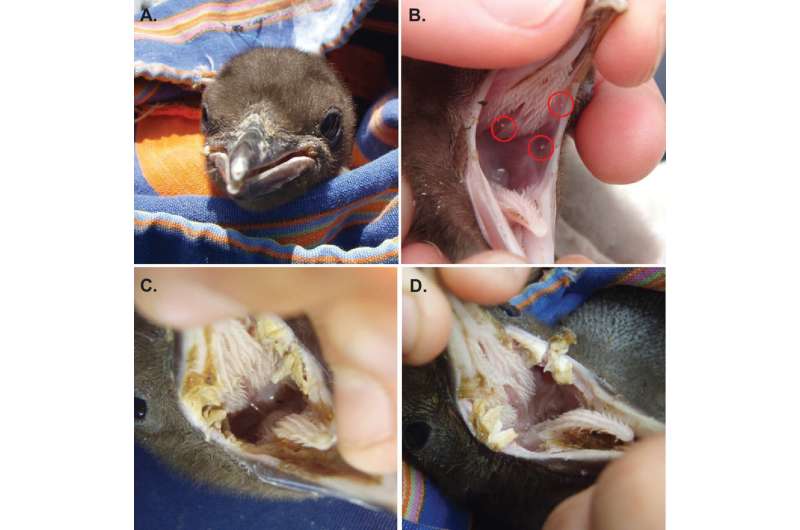FIG 1 Fibrinopurulent diphtheria lesions in yellow-eyed penguin chicks. (A) Lesions at the commissures of the beak, which prevent closure of the oral cavity. (B) Red circles denote minor “pinpoint” lesions in the gape and choanal slit that are firmly adhered to the mucosa before overgrowth of fibrinopurulent lesion exudate and mucosa ulceration. (C and D) Extensive fibrinopurulent diphtheria lesions in the oral cavity of infected yellow-eyed penguin chicks, including both sides of the gape and under the tongue. Photos: M. J. Young.
A team of researchers, led by Northumbria University, have been working to understand and develop a vaccine for an infection that's been killing off rare penguins in New Zealand.
Yellow-eyed penguins, locally known as hoiho (Māori name), are one of the world's rarest species. They are native to New Zealand and its outlying islands. Hoiho breeding pairs have been rapidly declining for over two decades, largely due to outbreaks of a diphtheria-like infection (diphtheritic stomatitis) that is fatal to young chicks.
The diseased chicks are commonly treated with antibiotics such as amoxicillin or enrofloxacin, but this course of treatment has often failed to save them.
The team, led by Dr. Vartul Sangal from the Department of Applied Sciences at Northumbria University, that includes scientists from the New Zealand Department of Conservation, the University of Otago and the Massey University, has identified a new species of bacteria which is causing these infections. The team has also discovered some proteins that could be used as a vaccine and may help protect the species from potential extinction due to these outbreaks.
Diphtheria is a serious infection in humans which is caused by toxin (poison) producing strains of the bacterium called Corynebacterium diphtheriae. A thick gray coating is often observed in the throat including the tonsils of the patients.
Similarly, diphtheria-like infections in Yellow-eyed penguins are caused by a new Corynebacterium species that affects chicks aged between one and 28 days. These infections are also characterized by a thick puss and ulceration in the mouth, which can prevent the chicks from eating—resulting in starvation and can also result in sepsis.
The research team took swabs from the mouths of Yellow-eyed penguin chicks from nests at four breeding sites of the Otago peninsula. Bacteria associated with diphtheria-like infections in chicks were isolated and genome sequences (DNA) were analyzed which helped understand how 'avian diphtheria' is attacking the penguin chicks and how it might be treated.
Dr. Sangal is an expert in cellular and molecular sciences who has researched diphtheria and related corynebacterial infections for almost a decade.
He explained: "Based on the genetic family tree (phylogenetic tree) made from the genome sequences (DNA), these strains were very distinct from other Corynebacterium species. We also tested the biochemical properties and found that these strains belong to a new species that has not been reported yet.
"We identified multiple disease-causing components (genes) in the genomes of these strains, which helped us understand the mechanism of infection. One of such components produces a protein, Phospholipase D that is important for infection and can potentially be used as a vaccine to protect yellow-eyed penguins.
"Interestingly, these strains also possessed unique DNA sequences which enabled us to develop a simple test to rapidly and reliably identify the infection. A rapid detection may help facilitate an early treatment of infected chicks, improving their chances of survival."
Kate McInnes, threatened species veterinarian at the Department of Conservation, said: "Yellow-eyed penguins, or hoiho as they are known in New Zealand, are a rapidly declining endangered species that are facing extinction in their northern range.
"This study has helped us to understand how the bacterium attacks its host, in this case, baby yellow-eyed penguins. It means that we can focus our treatments to ensure that more yellow-eyed penguin chicks survive."
According to Melanie Young, technical advisor at the Department of Conservation: "Avian diphtheria has affected up to 93% of hoiho chicks in their northern range for more than 20 years, with the disease being fatal if left untreated. If chicks don't survive year after year, this has a knock-on effect on population stability."
Dr. Sarah Saunderson, research fellow at the University of Otago, added: "The collaboration with Dr. Vartul Sangal and colleagues at Northumbria University has allowed us to make significant progress with this research.
"This research is an important diagnostic step in characterizing the virulence of the bacteria associated with this disease, with the hope that a vaccine can be developed for future prevention."
The full study, "Phylogenomic characterisation of a novel Corynebacterium species associated with fatal 'diphtheritic stomatitis' in endangered yellow-eyed penguins," has been published in the microbiology journal mSystems.
More information: Phylogenomic Characterization of a Novel Corynebacterium Species Associated with Fatal Diphtheritic Stomatitis in Endangered Yellow-Eyed Penguins. mSystems. DOI: doi.org/10.1128/mSystems.00320-21
Provided by Northumbria University
























